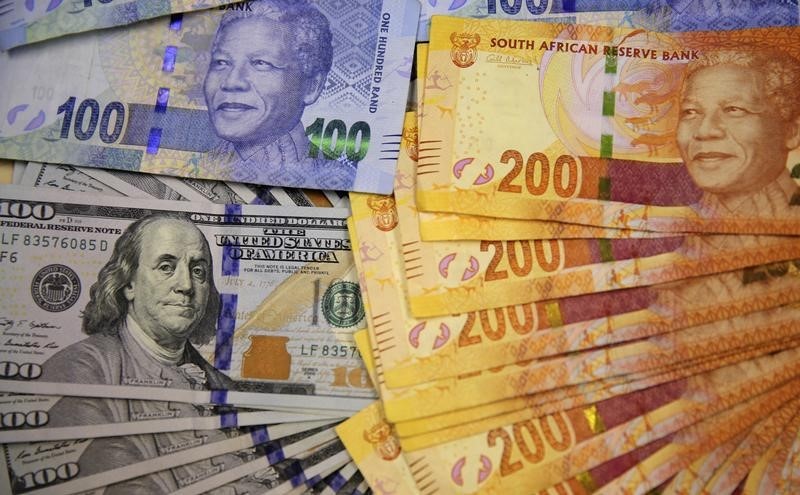
The world’s economic locomotive, the US economy, is approaching top speed. Latest data from the US revealed that the country which accounts for a quarter of global economic activity, grew at an annualised rate of 5% in the three months to end September, faster than at any other period since 2003. With another booster in prospect in the months ahead from the sharply lower oil price, despite all the misgivings, it is now apparent that Quantitative Easing has been successful. The US is once again sending a strong message – its system of free enterprise, unleashing human potential and thereby efficiently delivering goods and services, works better than any alternative yet proposed by mankind. A clear message for the command-and-control school whose currencies reflect their misguided policies. Read the report on another Rand reverse at the bottom of the page. – AH
By Lucia Mutikani
WASHINGTON, Dec 23 (Reuters) – The US economy grew at its quickest pace in 11 years in the third quarter, the strongest sign yet that growth has decisively shifted into higher gear.
The Commerce Department on Tuesday revised up its estimate of gross domestic product growth to a 5.0 percent annual pace, citing stronger consumer and business spending than it had previously assumed.
It was the fastest growth pace since the third quarter of 2003. The economy was previously reported to have expanded at a 3.9 percent rate.
GDP growth has now been revised up by a total of 1.5 percentage points since the first estimate was published in October. Big revisions are not unusual as the government does not have full information when it makes its initial estimates.
U.S. stock index futures extended their gains after the report, while U.S. Treasury debt yields rose slightly. The dollar rose to a fresh eight-year high against a basket of currencies.
The economy expanded at a 4.6 percent rate in the second quarter, meaning it has now experienced the two strongest back-to-back quarters of growth since 2003. Economists polled by Reuters had expected growth would be raised to a 4.3 percent pace.
But the pace of growth likely slowed in the fourth quarter.
In a second report, the Commerce Department said non-defense capital goods orders excluding aircraft, a closely watched proxy for business spending plans, was unchanged after declining 1.9 percent in October.
The continued weakness in the so-called capital goods orders is at odds with industrial production data, which has shown strong momentum in the manufacturing sector.
But a rapidly strengthening labor market and lower gasoline prices should provide the economy with sufficient momentum in 2015 and keep the Federal Reserve on course to start raising interest rates by the middle of next year.
Underscoring the economy’s firming fundamentals, growth in domestic demand was revised up to a 4.1 percent pace in the third quarter instead of the previously reported 3.2 percent pace. It was the fastest pace since the second quarter of 2010.
Consumer spending, which accounts for more than two-thirds of U.S. economic activity, grew at a 3.2 percent pace, the fastest since the fourth quarter of 2013, instead of the previously reported 2.2 percent rate.
Growth in business investment was raised to an 8.9 percent pace from a 7.1 percent rate, with a stronger pace of spending than previously thought on equipment, intellectual property products and nonresidential structures accounting for the revision.
Inventories were also revised higher, with restocking now being neutral to GDP growth instead of being a mild drag. That also helped to offset downward revisions to export growth.
But inventories could undercut output in the fourth quarter.
Spending on residential construction was also revised higher, as were government outlays. Export growth was cut to a 4.5 percent rate from the previously reported 4.9 percent pace, while imports were also revised down.
Rand retreats after strong US economy data
JOHANNESBURG (Reuters) – The rand retreated on Tuesday after data showed the US economy grew at its quickest pace 11 years in the third quarter, giving a clear lift to the dollar versus emerging market currencies such as South Africa’s.
At 1400 GMT, the rand was 0.50 percent weaker, fetching 11.62/dlr, after spending the session in a holding pattern in holiday-thinned trade.
The U.S. Commerce Department revised its estimate of gross domestic product growth to a 5.0 percent annual pace from 3.9 percent, citing stronger consumer and business spending than it had previously factored in.
The outlook for the rand remains bleak as portfolio investments into the stocks and bonds of Africa’s most advanced economy flow outward.
“Deteriorating sentiment towards emerging markets through the course of 2014 has culminated in net outflows in portfolio investments amounting to some 10.9 billion rand (year-to-date), the first time since 2008 that South Africa has experienced outflows,” ETM Analytics said in a note on Tuesday.
“Continued outflows could serve as a catalyst for the currency depreciative trend to extend,” it said.
The rand has shed 5 percent in December and over 25 percent in the last 12 months against the greenback, as a record 5-month labour stoppage in the platinum sector and tepid domestic growth have dented investor sentiment.
On the domestic debt front, the benchmark issue due in 2026 was unmoved at 8.00 percent.


